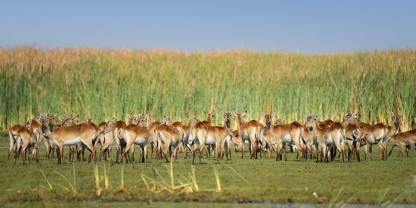Average Expert Rating
Rating Breakdown
Write a User ReviewDry scrub and lush wetlands
Coming by road from Monze (a junction town about 30 minutes’ drive from the entrance gate), you’ll drive for about 40km through a tract of dry grassland and miombo woodlands that is studded with termite mounds and supports sparse wildlife populations. Here we saw vervet monkey, baboon, common duiker and greater kudu. It is also reputedly still home to large numbers of spotted hyena.
This dusty road eventually brings you to the papyrus-lined southern shore of the Chunga Lagoon, which forms part of the Kafue Flats, a vast network of channels, islands, open lakes and seasonal floodplains fed by the Kafue River. This is one of the best sites in Zambia for aquatic birds. Driving as far as we could along the shore, then walking on further, we saw large flocks of glossy ibis, spur-winged goose and open-billed stork, and ticked off dozens of other species,
Read more
of which African pygmy-goose seems to be especially common. Other interesting birds included Hartlaub’s babbler, swamp flycatcher (at the very southern end of its range), western marsh harrier and copper-tailed coucal. We also saw a few herds of Kafue lechwe, a striking semi-aquatic antelope that is near-endemic to the Kafue Flats, though these were far less numerous than in Blue Lagoon National Park (Lochinvar’s northern counterpart), and relatively unapproachable.A disappointing aspect of this national park is that, following the closure of its only lodge a few years back, it is not possible to take a boat out onto the lagoon. This means you're unlikely to encounter any hippos or crocodiles, nor to see the large flocks of pelican, flamingo or African skimmer for which the park is famed.
As with Blue Lagoon, Lochinvar is a niche destination that is highly recommended to bird-watchers (for whom it is an easy day diversion from the main road between Lusaka and Livingstone), but unlikely to hold much appeal to other visitors.
Lonely marshlands beside the Kafue River
The Scottish cattle farmer who gave Lochinvar its name in the 1900s managed to wipe out most of the large mammals in this region and, despite more recent conservation and rehabilitation efforts, the situation has never really recovered. Like its near-neighbour Blue Lagoon National Park, Lochinvar is no match for Kafue National Park, which dominates this part of Zambia. However, it’s good for birding, and birdwatchers who make the effort to get here will find conditions more comfortable and more fruitful than in Blue Lagoon.
Few do make the trip, though, and the park felt spectacularly empty when I visited, so it’s a good choice for those who enjoy a little solitude on safari. It’s also good for those who enjoy watching antelopes – with few predators around apart from opportunistic villagers, the Kafue lechwe seem to be flourishing.

